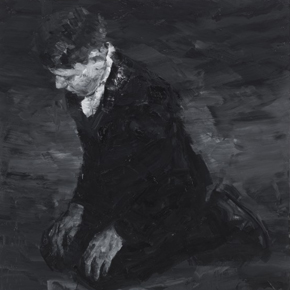David Zwirner is the man
David Zwirner’s gallery is first on my list whenever I’m in the city, and he rarely disappoints. His current show, Black Paintings, by Yan Pei-Ming, expands this Chinese artist’s ambitions, which until now seem to have centered mostly on large-scale portraiture. He was unable to achieve an education in art in his native China, and he moved to Paris to study painting, where he has remained and has found himself swept into international art fairs, high-priced sales for his work at auction, and even a small conceptual-looking installation of his paintings at the Louvre. Nice work if you can get it. In 2009, he exhibited his portrait of Obama at Miami Art Basel. Last year, his portrait of Mao sold for half a million pounds in London, with bidders from 11 different countries. And only a few days ago, Zwirner unveiled Yan’s portrait of Lady Gaga at the Hong Kong International Air Fair. Hey, nobody’s perfect.
With this new show, Yan’s reached much further than before, and he’s succeeded. These heroically scaled paintings—they feel as wide as a movie screen—are done in his typical grisaille, and in this new show he’s taken the values down into Tonalist territory, as dark as you can get and still depict something, with subjects almost obscured by the enveloping gloom. His vigorous brushwork brings to mind Lucien Freud, Natalie Frank’s portraits, even Jenny Saville, if she traded her flesh tones for oils pigmented with charcoal. Ostensibly inspired by Goya’s late wall paintings, which include visionary scenes and nightmarish depictions of horrific and occult subjects, these paintings seem even more liminal than the Spanish master’s. Up close, you recognize almost nothing but an impenetrable ocean of paint, and it’s a rough, choppy ride for the eye, from any angle. But the further back you stand, the more the images slowly resolve into life. The artist’s previous work has had political overtones, and it’s present here in Ghadhafi’s Corpse and his near-copy of Goya’s Execution and even in his apocalyptic painting of crows, if you look long enough to recognize the setting. Yet the Goya pastiche reproduces that collective murder in a void, with no indicators of time or place. The three paintings that form the heart of this show seem to take his anxieties to a spiritual precipice: his portrait of Picasso as a penitent young man, a depiction of a lifeboat adrift at sea, and a storm of crows swirling and darkening a night sky in Athens. All Crows Under the Sun are Black! feels like a scene Hitchcock might have crafted for his version of the Book of Revelations: oppressive and inexorably foreboding. The end of something enormous is at hand, or the beginning– Democracy itself (depending on where you live) given the Parthenon tucked into shadow under that sky. The horror he shows you seems near and alluring in a weird way and maybe is an expansion on his image of the Arab Spring. You want to slip into that image and find a place to hide, or participate. In Moonlight, he seems to have offered a slightly more hopeful version of Gericault’s Raft of the Medusa, a lifeboat tossing in the sea with the beacon of an oncoming rescue vessel on the horizon. It’s oddly uplifting, unlike its predecessor, which feels like a melodramatic summer blockbuster by comparison. With his portrait of Picasso, he’s envisioned the artist as a young man on his knees, his head bowed, apparently dressed for a ceremony, obedient and humble. It’s the most interesting image in the show. This legendary alpha dog of visual art is posed as a servant or vassal or devotee; and this is a man who probably represents for most of us the paradigm of the artist as a someone who lives by his own rules, governed only by his self-assertive male prerogatives. Instead, Picasso here is seated on his knees in a supplicant pose, hands placed carefully on his legs, his gaze averted, as if he’s waiting for instruction or an inner rescue or blessing. These paintings are as large as anybody’s ego, yet that spectacular scale is undercut in every way. The images are vulnerable and understated, with a reverence for uncertainty and the unknown, and they offer only enough information for the imagination to do most of the work. They feel like an almost unwilling personal exposure: exactly the way Goya’s Black Paintings did, meant only for his own eyes and no one else’s. These few images, together, have a tremendous impact, both emotional and imaginative, and as black as they are, they aren’t oppressive, but thrilling. They balance horror with a life-affirming awe, and the despair they seem to embody has to contend with a far more interesting and artistically defiant note of transcendence.

Comments are currently closed.